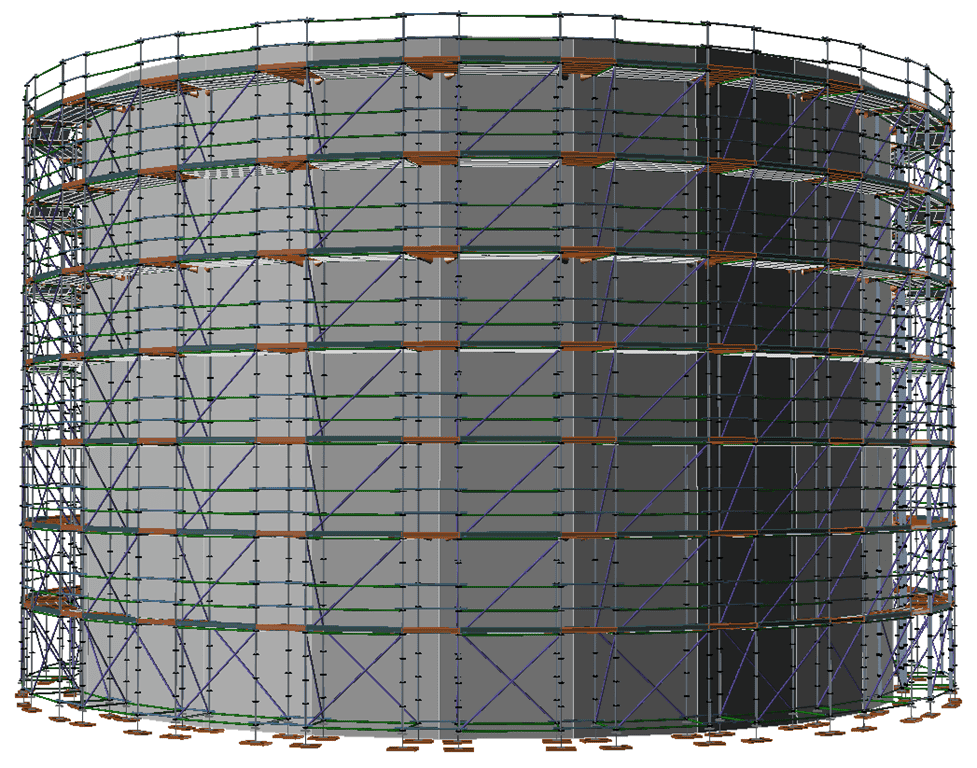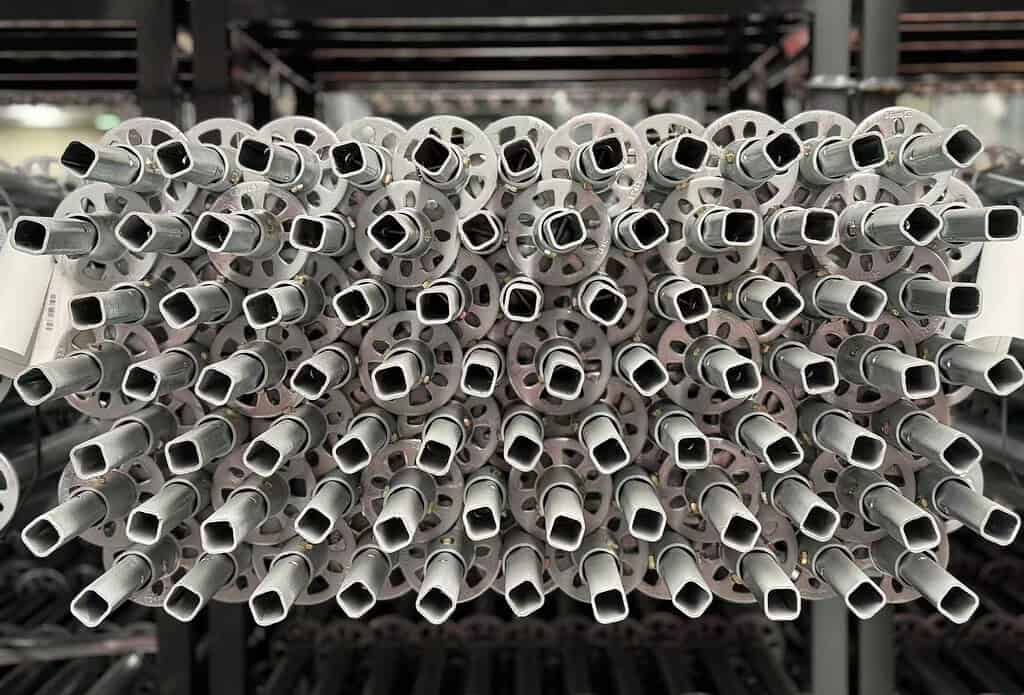 Para calcular a taxa de andaimes, você precisa considerar vários fatores. Aqui está um guia passo a passo para ajudar você a determinar a taxa de andaimes:
Para calcular a taxa de andaimes, você precisa considerar vários fatores. Aqui está um guia passo a passo para ajudar você a determinar a taxa de andaimes:1. Calcule a área total
Primeiro, determine a área total que precisa de cobertura de andaimes:- Altura x Largura x Profundidade = Área total em metros cúbicos (m³)
2. Determine a taxa base
A taxa básica média para andaimes em muitas áreas é de cerca de £ 20 por metro quadrado (m²)No entanto, isso pode variar de acordo com a localização e as especificações do projeto.
3. Considere os custos adicionais
Considere estes elementos adicionais que podem afetar a taxa:- Duração do Projeto: Projetos mais longos podem ter taxas diferentes.
- Complexidade:Formatos ou alturas incomuns podem aumentar os custos.
- Acesso: Áreas de difícil acesso podem incorrer em custos extras.
- Características de segurança: Requisitos adicionais de segurança podem afetar a tarifa.
4. Calcular custos de material
Estime os custos do material:- Tubos/Postes: Cerca de 50% de custos de material
- Placas e acessórios: Restantes 50% de custos de material
5. Incluir custos de mão de obra
Os custos de mão de obra são um fator significativo. Algumas empresas usam um multiplicador de 2,5 vezes o custo de mão de obra para determinar a taxa total.6. Considere a localização
As taxas podem variar um pouco entre as cidades, mas a concorrência geralmente mantém os preços semelhantes. Por exemplo, os custos de andaimes em Londres e Manchester são geralmente comparáveis.7. Aplique a taxa
Depois de ter todos esses fatores, você pode calcular a taxa: (Taxa Base x Área Total) + Custos Adicionais = Taxa Total de AndaimesExemplo de cálculo:
Para uma área de 10m² (5m x 2m) com 2,8m de altura:- Área total: 5m x 2m x 2,8m = 28m³
- Taxa base: £ 20/m² x 28m³ = £ 560
- Adicionar custos de mão de obra e material (varia de acordo com o projeto)
- Inclua quaisquer custos adicionais de complexidade ou duração
Índice
Agora que você tem uma compreensão básica dos fatores envolvidos, vamos analisar cada elemento que influencia os preços dos andaimes e como calcular o custo do seu projeto de construção.

Quais fatores influenciam as taxas de andaimes?
Confuso sobre variáveis de custo? As taxas de andaimes dependem de fatores como área, altura, tipo de andaime, duração do projeto, e custos de mão de obra. Cada um desses elementos desempenha um papel crucial na precificação.
As taxas de andaimes são influenciadas por vários fatores: tamanho da área, altura da estrutura, tipo de andaime (suportado ou suspenso), custos de mão de obra, e o duração de uso. Esses aspectos devem ser cuidadosamente considerados para obter uma estimativa de custo precisa para o projeto.
A taxa de andaimes é determinada por vários fatores-chave. A área coberta pelo andaime é um dos principais impulsionadores de custos, pois projetos maiores exigem mais materiais e mão de obra. altura da estrutura também impacta significativamente o custo, pois edifícios mais altos precisam de sistemas de andaimes mais fortes e medidas de segurança mais abrangentes. O tipo de andaime, seja ele andaime apoiado, andaime suspenso, ou andaime rolante, também afetará os preços, com alguns tipos sendo mais caros devido a componentes especializados. Custos de mão de obra são outro fator essencial, pois montar e desmontar andaimes pode ser trabalhoso. Finalmente, o duração o andaime necessário para o projeto contribuirá para o custo, com projetos mais longos resultando em taxas mais altas.
Como calcular a área para andaimes?
Não sabe como calcular a área? O área para andaimes é calculado multiplicando o altura da estrutura pelo perímetro do edifício, que determina o espaço total coberto.
Para calcular o área para andaimes, multiplique o altura do edifício pelo perímetro da estrutura. Esta fórmula fornece a área total coberta pelo andaime, ajudando você a estimar os custos com base na metragem quadrada.
Calculando o área para andaimes é um dos primeiros passos para determinar a taxa. A fórmula mais comum usada é multiplicar a altura da estrutura pelo perímetro do edifício. Por exemplo, se um edifício tem 30 metros de altura e o perímetro é de 60 metros, a área total do andaime seria de 1.800 metros quadrados. Esta área ajudará você a estimar a quantidade de material de andaime necessária, e o custo será calculado por metro quadrado. Algumas empresas também podem levar em consideração componentes adicionais, como passarelas, escadas, ou guarda-corpos, o que pode afetar a área total e o custo.
Como calcular andaimes por m²?
Quer saber sobre os custos por metro quadrado? O andaime por m² é calculado multiplicando-se o total área coberta pela taxa fornecida por m², considerando material, mão de obra e elementos de segurança.
Para calcular custos de andaimes por m², multiplicar o total área em metros quadrados pela taxa de andaimes, que inclui material, trabalho, e medidas de segurança adicionais. Este método ajuda a estimar com precisão a despesa total do seu projeto.
Custos de andaimes são frequentemente calculados em um base por metro quadrado para fornecer uma estimativa precisa para projetos de construção. Primeiro, meça o altura e perímetro da estrutura para determinar a área total coberta em metros quadrados. Depois de ter a área total, multiplique-a pela taxa por m² fornecido pela empresa de andaimes. Esta taxa normalmente inclui o custos de material, custos de mão de obra, e características de segurança necessário para o projeto. Por exemplo, se a área total for 1.000 m² e a taxa por m² for $5, o custo total do andaime seria $5.000.
Qual é a capacidade de carga de um andaime?
Preocupado com a capacidade de carga? O classificação de carga A qualidade do andaime é determinada pelo seu design e pelos materiais utilizados, garantindo que ele possa suportar com segurança trabalhadores, equipamentos e materiais durante a construção.
Os andaimes devem ter uma estrutura específica classificação de carga para garantir a segurança. As três classificações de carga primárias são serviço leve (até 120 kg/m²), serviço médio (até 240 kg/m²) e serviço pesado (até 450 kg/m²), dependendo das necessidades do projeto.
O classificação de carga de andaimes refere-se ao peso máximo que ele pode suportar com segurança, incluindo trabalhadores, ferramentas e materiais. Andaimes são normalmente classificados em três categorias: serviço leve andaimes podem suportar até 120 kg/m², serviço médio andaimes podem suportar até 240 kg/m², e serviço pesado andaimes podem suportar até 450 kg/m². A escolha da classificação de carga apropriada é crucial para garantir a segurança dos trabalhadores e evitar falhas no andaime durante o projeto. A capacidade de carga também dependerá do tipo de andaime usado e do número de plataformas ou níveis envolvidos.
Como os custos de mão de obra afetam as taxas de andaimes?
Preocupado com os custos de mão de obra? Os custos de mão de obra podem afetar significativamente os preços dos andaimes, pois a montagem, a desmontagem e as verificações de segurança exigem trabalhadores qualificados para garantir que o andaime esteja estável e seguro.
Custos de mão de obra são um fator significativo no preço de andaimes. Montar e desmontar andaimes requer habilidades especializadas, e procedimentos de segurança devem ser seguidos para garantir uma estrutura segura. Quanto mais longo e complexo o projeto, maiores os custos de mão de obra.
Custos de mão de obra são uma parte importante do cálculo da taxa geral de andaimes. O processo de montagem e desmontando andaimes são trabalhosos e exigem trabalhadores qualificados para garantir que a estrutura seja segura e esteja em conformidade com os regulamentos de segurança. Dependendo da complexidade do projeto, como se o andaime precisasse ser construído em torno de superfícies irregulares ou em grandes alturas, os custos de mão de obra podem aumentar. Além disso, inspeções de segurança e ajustes durante o projeto também podem aumentar as despesas de mão de obra. Quanto mais tempo o andaime for necessário, mais mão de obra estará envolvida, aumentando assim o custo.
Conclusão
Concluindo, as taxas de andaimes são influenciadas por fatores como área, altura, tipo e mão de obra, com considerações adicionais para classificação de carga e capacidade. Calcular com precisão essas variáveis garante uma estimativa clara dos custos de andaimes do seu projeto.
